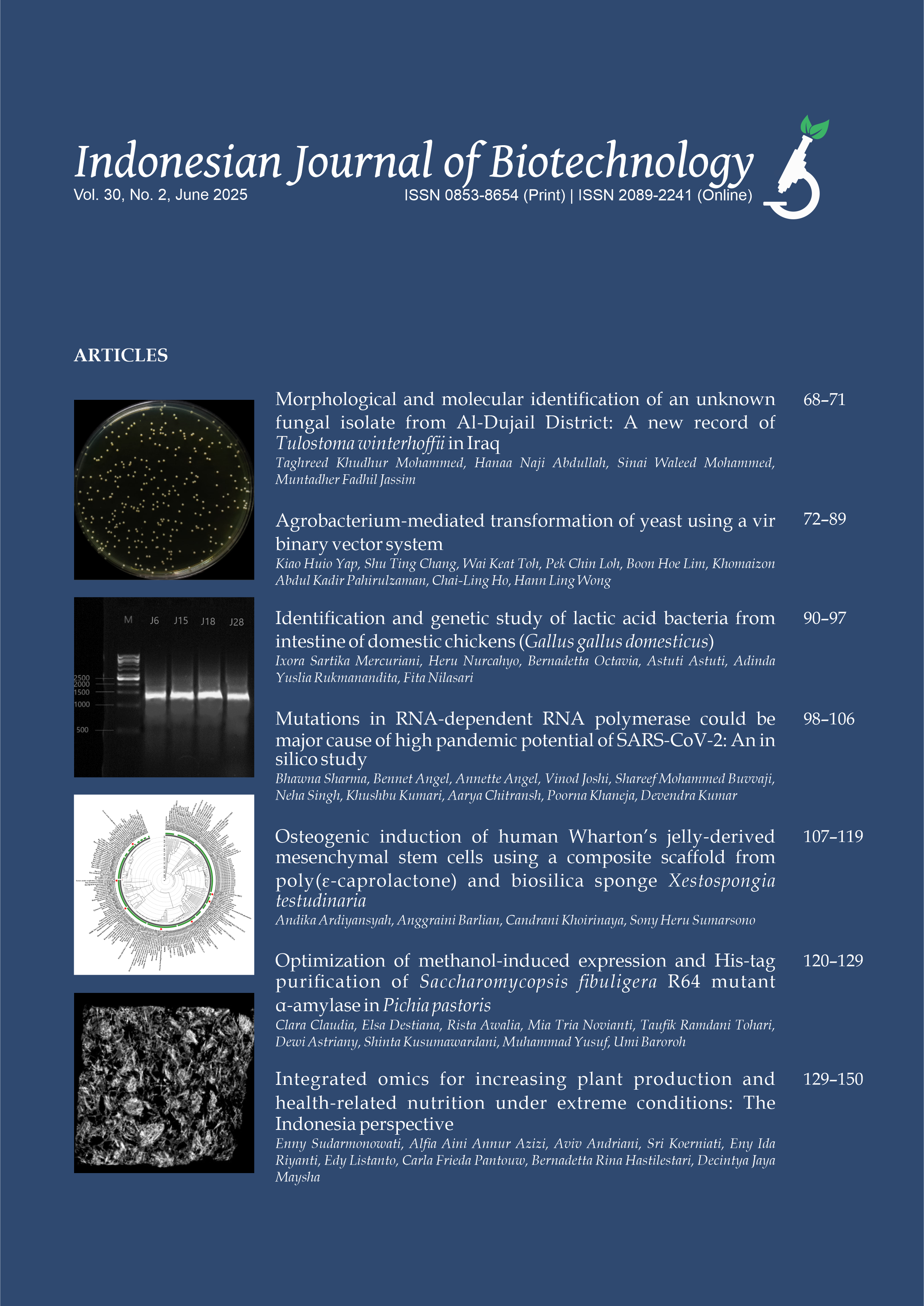Cytotoxicity of Buah Merah (Pandanus conoideus Lamk.) Extract on Breast Cancer Cell Line (T47D)
Tri R. Nuringtyas(1*), Yoga Pratama(2), G. Galih(3), Subagus Wahyuono(4), Sukarti Moeljopawiro(5)
(1)
(2)
(3)
(4)
(5)
(*) Corresponding Author
Abstract
Buah Merah (Pandanus conoideus Lamk.) has been extensively used to treat various diseases including
cancer. There are many varieties of buah merah and there was no scientifi c study comparing cytotoxicity of
different varieties. The objective of this study was to investigate the cytotoxicity of three varieties of buah merah
known as Barugum, Maler and Yanggiru on breast cancer cell line (T47D). All samples were collected from
Papua, Indonesia. Each sample was extracted consecutively using three solvents chloroform, methanol and
water resulted to nine crude extracts. The cytotoxic activities were determined using MTT assay. The crude
extract showed the lowest IC50 was selected for further bioassay-guided fractionation. Fractionation was done
using vacuum liquid chromatography coupled with preparative TLC to fi nd the active compounds. Several
detection reagents were applied to TLC for identifi cation of the class of the potent compounds. The result
showed that the potent extracts was obtained from Barugum methanol extract followed by Maler chloroform
extract with IC50 value of 132.83 μg/ml and 139.72 μg/ml, respectively. All Yanggiru extracts did not show
activity. The bioassay-guided fractionation of Barugum and Maler extracts showed that the most potent fraction
eluted by a mixture of hexane:ethyl acetate (75:25), was in Maler variety with IC50 value of 25,7 μg/ml, four
times higher than the most potent fraction of Barugum with IC50 value of 104,61 μg/ml. TLC analysis of the
most potent fraction showed that the active compounds was class of terpene. Result of this study supported
the utilization of buah merah Maler variety for breast cancer treatment.
cancer. There are many varieties of buah merah and there was no scientifi c study comparing cytotoxicity of
different varieties. The objective of this study was to investigate the cytotoxicity of three varieties of buah merah
known as Barugum, Maler and Yanggiru on breast cancer cell line (T47D). All samples were collected from
Papua, Indonesia. Each sample was extracted consecutively using three solvents chloroform, methanol and
water resulted to nine crude extracts. The cytotoxic activities were determined using MTT assay. The crude
extract showed the lowest IC50 was selected for further bioassay-guided fractionation. Fractionation was done
using vacuum liquid chromatography coupled with preparative TLC to fi nd the active compounds. Several
detection reagents were applied to TLC for identifi cation of the class of the potent compounds. The result
showed that the potent extracts was obtained from Barugum methanol extract followed by Maler chloroform
extract with IC50 value of 132.83 μg/ml and 139.72 μg/ml, respectively. All Yanggiru extracts did not show
activity. The bioassay-guided fractionation of Barugum and Maler extracts showed that the most potent fraction
eluted by a mixture of hexane:ethyl acetate (75:25), was in Maler variety with IC50 value of 25,7 μg/ml, four
times higher than the most potent fraction of Barugum with IC50 value of 104,61 μg/ml. TLC analysis of the
most potent fraction showed that the active compounds was class of terpene. Result of this study supported
the utilization of buah merah Maler variety for breast cancer treatment.
Keywords
Buah Merah; cytotoxicity; T47D; vacuum liquid chromatography; thin-layer chromatography
Full Text:
PDFArticle Metrics
Refbacks
- There are currently no refbacks.
Copyright (c) 2015 Tri R Nuringtyas, Yoga Pratama, Galih G, Subagus Wahyuono, Sukarti Moeljopawiro

This work is licensed under a Creative Commons Attribution-ShareAlike 4.0 International License.









